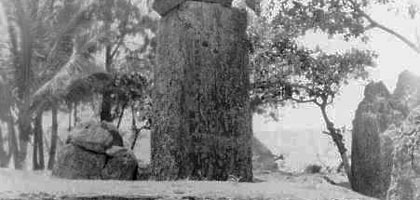

| the expedition | |
| the science | |
| tools & techniques | |
| daily journal | |
| the team | |
| questions & answers | |
|
the islands Saipan Anatahan Sarigan Guguan Alamagan Pagan Agrigan Asuncion Maug Uracas |
|
|||||||||||||||||||||||||||||||||||||||||||||||||||||||||||||||
The Chamorro

The island archipelago that includes the Marianas was formed between 25 and 50 million years ago as two plates of oceanic crust, the Pacific and the Philippine, collided and touched off volcanic activity. The resulting volcanic mountains, if measured from the seafloor, are as much as 5,000 feet taller than Mt. Everest, which stands 29,028 feet above sea level.
Archaeological records indicate that people first inhabited these rugged volcanic mountaintops as early as 2,000 B.C. Those first settlers came from Southeast Asia; the language they spoke and customs they kept bears similarities to those of their contemporaries in Indonesia, Malaysia and the Philippines.
Though it is possible that they first came upon the islands after getting lost navigating the waters of the western Pacific Ocean, in time, the people who became known as the Chamorro distinguished themselves as accomplished mariners and fishermen as well as skilled horticulturalists.
Society organized itself at the village level with two or three levels of social rank. Family structures were matrilineal and women were the heads of households, a feature credited for keeping Chamorro culture alive despite attempts of colonizers to abolish it starting in the 16th Century.
Chamorro islanders would traverse local waters in vast canoes called sakman, the distinctive triangular sails of which would lead one of the first westerners ever to see the Chamorro, the Spanish explorer Ferdinand Magellan, to originally give the Marianas the name "Las Islas de las Velas Latinas," ("The Islands of the Latin Sails") because of their resemblance to the small vessels he knew from the Mediterranean Sea near his home. The native sailors had no charts or compasses, but instead used the positions of stars committed to memory and their knowledge of waves and clouds to guess the direction of the current.

Back on their home islands, the Chamorros underwent a distinct cultural transformation some 1,000 years ago. It manifest itself in a new architectural expression, the latte stones constructed at Chamorro homes that would become the namesake of the period that lasted from then until the first contact with the Spanish in 1521. The two-piece structures were columns and caps made of coral limestone. They were dragged several miles from quarries to houses. At the bases of latte stones, the Chamorro buried their dead and their valuables. Among a people known to have practiced ancestor worship, the stones were sacred and to this day, they remain a symbol of the peoples of the Marianas.
Though the Chamorro prized their canoes and jewelry as personal possessions, their concepts of ownership were different than those of their first Spanish visitors. That culture clash set the tone for what was to follow in the days, months and years after Chamorro warriors paddled out to greet Magellan, their first Western visitor, on March 6, 1521 as he dropped anchor off the island of Guam.
